Understanding the Samsung Range of SSDs – Pro, Plus, Evo
Of all the SSD brands in the home and business sector, there are not many brands that have had the meteoric impact on the memory and SSD market that Samsung has. One of the earliest providers of flash technology for the consumer and commercial level, they have existed either overtly in the market, or in the background of most technology in one shape or form for decades. In the SSD market, they have had more consistent success with their Pro, Evo and Plus range (spanning several subcategories) than Western Digital and Seagate combined. Currently when it comes to buying a new SSD for your laptop, desktop PC, home console or portable screen device, they have a drive for practically every need and if you can work out the naming convention and naming strategy (which is a little more elusive than the popular WD colours method admittedly) it is surprisingly easy to choose the right Solid State Drive you need, first time! So, below I have covered the main product families, their advantages, disadvantages and what they are best suited for. Let’s begin.
Choosing the Right Samsung SSD – A Guide to the Terminology
Before we discuss each of the Samsung SSD family members, it is worth highlighting some of the most common buying factors that affect the performance and durability of an SSD. It is with these that you can measure the suitability of the SSD with your own personal/business needs. Often the higher the capacity of an SSD, the lower the durability (unless you go towards exceptionally high-end NAND), or the fact that the most expensive SSD does not always guarantee the highest IOPs, or negate the lower drive writes per day. Below are the key factors that you should keep an eye on when looking at the specifications and build of an SSD.
NAND Types (the Cells/Chips used in the SSD) –
- SLC: Single-level cell NAND flash supports 50,000 to 100,000 write cycles
- MLC: The 2-bit data multi-level cell (MLC) flash generally takes up to 3,000 write cycles. eMLC (enterprise MLC) sustains up to10,000 write cycles, and can reach 35,000 cycles on 3D NAND
- TLC: Triple-level cells (3-bit) NAND flash is low at 300-1000 write cycles, and can achieve 1500-3000 write cycles with 3D NAND
- QLC: Quad Layer Cells, featuring 4 Bit flash – Highest Capacity available at the lowest price, but lower durability overall. Requires improved controllers for stability
- 3D NAND Technique – Method of stacking/writing data vertically on chips, resulting in even faster retrieval and more efficient space utilization. Often featured with TLC and MLC NAND
- eXLC – Often featured as eMLC, eTLC, and eQLC, it is an enterprise-quality build and utilization of the existing MLC/TLC/QLCNAND usually featured for improved consistent speeds and more write cycles on balance
TCO – Total Cost of Ownership, In a TCO calculation, cost per gigabyte still has a role, but it’s only a very small part of a much bigger picture. Other metrics – such as IOPS per watt and capacity and performance per rack – also come into play. The truth is that TCO can’t be measured with any single metric; it’s a mix of several measures that should be weighted according to the unique workloads of the storage system.
IOPS – Input/output operations per second – (IOPS, pronounced eye-ops) is an input/output performance measurement used to characterize computer storage devices like hard disk drives (HDD), solid-state drives (SSD), and storage area networks (SAN).
TBW – Terabytes Written – measures how much you can write cumulatively into the drive over its lifetime
DWPD – Drive Writes Per Day – specification of a drive to calculate the number of times that the user capacity of a drive can be written per day over the warranty period
TBW ÷ (warranty years × 365 days/year× Drive Capacity in GB) = # DWPD
MTBF – Mean Time Between Failures, is a popular measurement for HDDs but not as meaningful for SDDs.
ECC – (error correction code) software corrects random bit errors that are quite common in NAND flash, and helps to correct bit errors from wear. By correcting both types of errors, ECC lengthens the lifetime of a block.
TRIM – These commands are not typically error-checking tools, but do improve performance by immediately wiping deleted pages or blocks. Without TRIM, the SSD controller does not actually wipe deleted data until it is ready to write new data to the same location9
So, there you have the terminology of Samsung SSDs (and SSDs in general really), so let’s discuss each of the key ranges from Samsung in their Pro, EVO and Plus series and which one is best for you.
The Samsung 860 Evo and Pro Range – Oldie But A Goodie
The Samsung 860 PRO and 860 EVO SSDs (originally released way back in 2018) combine the 512Gb and 256Gb 64-layer V-NAND, with up to 4GB LPDDR4 mobile DRAM and an in-house MJX controller. Although many drives have come along in the meantime (both from Samsung and rival brands) the 860 Pro and Evo are STILL solid and excellent value SSD. Available in both SATA 2.5″ form factor interface and the now widely available m.2, these were the follow up to the 850 Pro and Evo (which were already around for 3yrs when these were launched), they have never really stopped being popular in terms of price vs capacity and performance. Better suited towards home and single-drive PC use in businesses, they are often found in most consumer-grade laptop bundles.
| Suitable For | Not Suitable For |
| PC Boot Disk
XBox/PS4 Storage Fast Post Production Backups Mobile Devices (mSATA & M.2) Surveillance/Compact NVRs |
NAS Caching
Photo/Video Editing Large Scale Post Production Flash Storage |
In terms of their performance and utility, Samsung’s 860 PRO and 860 EVO support up to 560 MB/s read and 530 MB/s write, offering a decent level of reliability with a standard (for SSD) five-year limited warranty, or up to 4,800 terabytes written (TBW) for the 860 PRO and up to 2,400 TBW for the 860 EVO. The MJX controller also enables faster communication with the host system, but has since been superseded by more enterprise-grade controllers in 2020. Regardless, the controller is powerful enough to handle workstation storage and OS boots, while improving Linux operating system compatibility.
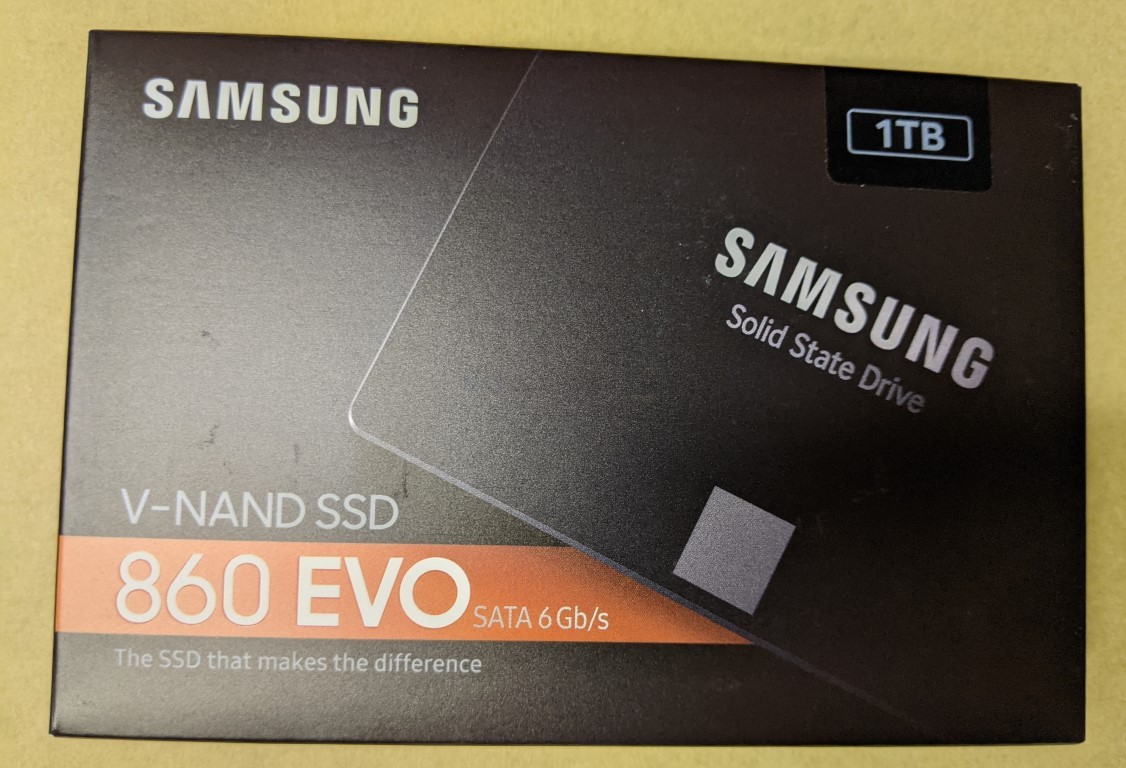 |
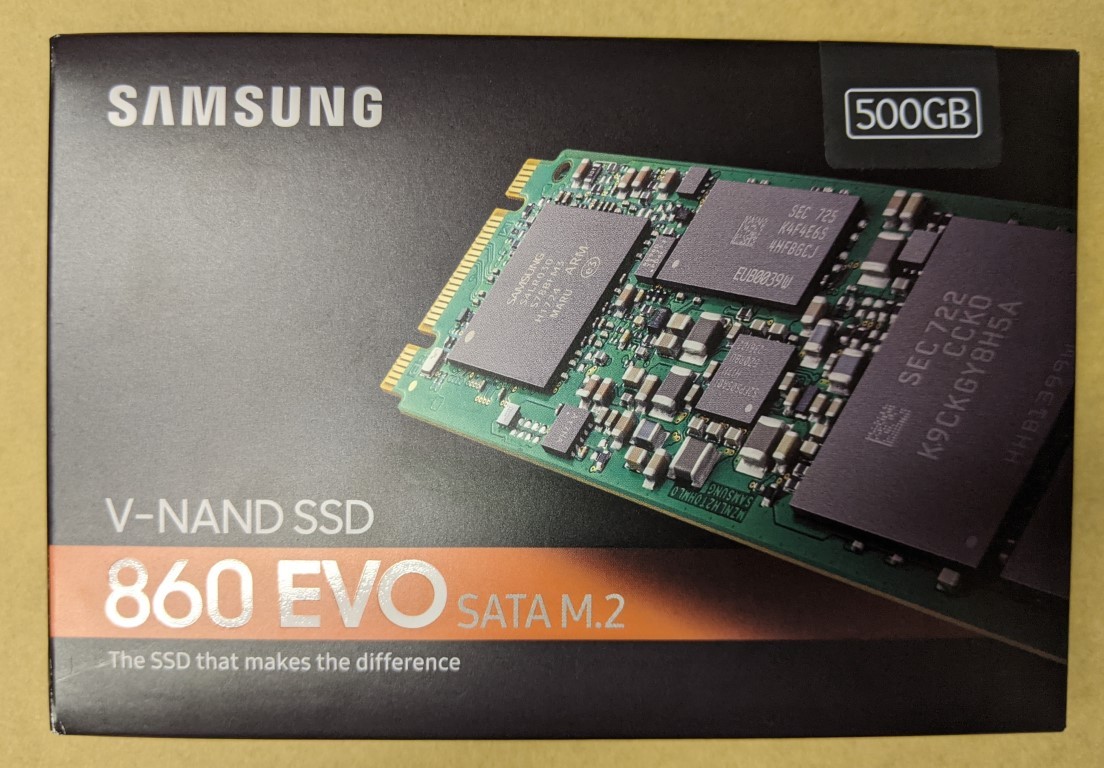 |
Regarding capacity (a valid long term concern) the Samsung 860 PRO are available in 256GB, 512GB, 1TB, 2TB and 4TB capacities. To save you doing the maths, in modern recording terms that means the PRO 4TB memory storage holds up to 114 hours and 30 minutes of 4K Ultra HD video. Additionally, the Samsung 860 PRO is ONLY available in 2.5-inch form factor, which is ideal for PCs, laptops, workstations and NAS, but makes it much less convenient for NAS cache implementation without losing valuable main-storage bays, The Samsung 860 EVO, on the other hand, though similar has some key differences, still arriving in 250GB, 500GB, 1TB, 2TB and 4TB capacities in a 2.5-inch for PCs and laptops, there is also a range of mSATA and M.2 interface/size drives in 250GB-2TB for ultra-slim computing applications and NAS caching bays. The 860 EVO has up to six times longer sustained performance than the 850 range that came before due to the built-in Intelligent TurboWrite gearing, with reported read and write speeds of up to 550 MB/s and 520 MB/s, respectively.
| Category | 860 PRO | 860 EVO |
| Design | 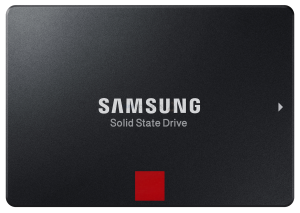 |
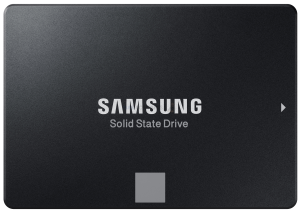
|
|
|
||
| Interface | SATA 6 Gbps | |
| Form Factor | 2.5-inch | 2.5-inch, mSATA, M.2 |
| Storage Memory | Samsung V-NAND 2bit MLC | Samsung V-NAND 3bit MLC |
| Controller | Samsung MJX Controller | |
| Cache Memory | 4GB LPDDR4 (4TB) 2GB LPDDR4 (2TB) 1GB LPDDR4 (1TB) 512MB LPDDR4 (256/512GB) |
4GB LPDDR4 (4TB) 2GB LPDDR4 (2TB) 1GB LPDDR4 (1TB) 512MB LPDDR4 (250/500GB) |
| Capacity | 4TB, 2TB, 1TB, 512GB, 256GB | [2.5-inch] 4TB, 2TB,1TB,500GB, 250GB [M.2] 2TB, 1TB, 500GB, 250GB [mSATA] 1TB, 500GB, 250GB |
| Seq.Read/Write Speed | Up to 560/530 MB/s | Up to 550/520 MB/s |
| Ran.Read/Write Speed (QD32) | Max. 100K IOPS / 90K IOPS | Max. 98K IOPS / 90K IOPS |
| Device Sleep | 2.5 mW for 1TB (Up to 7 mW for 4TB) |
2.6 mW for 1TB (Up to 8 mW for 4TB) |
| Management SW | Magician Software for SSD management | |
| Total Byte Written | 4TB: 4,800TB 2TB: 2,400TB 1TB: 1,200TB 512GB: 600TB 256GB: 300TB |
4TB: 2,400TB 2TB: 1,200TB 1TB: 600TB 500GB: 300TB 250GB: 150TB |
| Warranty | 5 years or up to 4,800 TBW 9 | 5 years or up to 2,400 TBW |
The Samsung 870 Evo and Samsung 870 QVO – Best All Round SSD for Consumer Use
Now, we can move into more modern releases from Samsung with the Samsung 870 series. However, it is worth noting that I have combined two quite different SSDs under one group here (much like Samsung has done by giving both of these drives the 870 prefixes), but it is actually pretty important to know the difference between them. Although we generally associate to label EVO with a more affordable/lower performance drive, it is worth highlighting that the Samsung 870 EVO in this context is actually better for many buyers who want a more long term endurance drive (i.e the NAND media to last longer) and higher sustained Read and Write via a SATA connection. This is because the Samsung 870 QVO uses QLC (Quad-Layer) NAND for it’s storage and the 870 EVO uses TLC (Triple-Layer) NAND. The result is that the 870 QVO will have larger capacities available (up to 8TB in fact, twice that of the 4TB in the 870 EVO) but will have a lower sustained performance accordingly, lower IOPS and will wear out sooner (i.e. the Samsung 870 QVO has a lower Terabytes Written in its lifespan than the 870 EVO).
| Suitable For | Not Suitable For |
|
Non-Competitive (Single Player) PC Gaming NAS Caching Bulk System Storage Small Scale Flash Storage (NOT the 870 QVO) Some Black Magic Cameras (Check Compatibility) |
1080/4K Video Editing Suites Data Center Use Long Term Storage RAID Environments |
Starting with the older drive of the two, the Samsung 870 QVO (the 2nd generation, following the 860 QVO). The Samsung 870 QVO surprisingly still managed to provide best-in-class sequential read and write speeds of up to 560 MB/s and 530 MB/s respectively (through sustained performance drops a little), with the drive’s Intelligent TurboWrite feature once again, allowing it to maintain peak performance levels using a large variable SLC buffer. Compared with its predecessor, the Samsung 870 QVO also delivers a 13% improvement in random read speed over the 2018 released Samsung 860 QVO, making it suited for everyday computing needs such as multitasking, gaming and web browsing, but certainly not for mission-critical data, archiving or sustained write/wipe/repeat use (i.e NAS cache). This is still a very good SSD, but even in this latest revision, I would not recommend a QLC NAND SSD for anything other than low-level data use for data that is of a lower frequency repeat-write. In terms of its long term lifespan, Samsung has sensibly scaled this in line with the NAND longevity, rating the Samsung 870 QVO an endurance rating of up to 2,880 terabytes written (TBW), or a three-year limited warranty.

Whereas, the Samsung 870 EVO is a much more progressive evolution compared with the 870 QVO, featuring the latest V-NAND and controller that Samsung has developed, allowing it to reach the maximum and heavily sustained SATA sequential read and write speeds of 560MB/s Read and 530MB/s Write. The key advantage that the 870 EVO has over the QVO is (of course) that NAND, which allows the data bandwidth to be more consistently high (same goes for IOPS), despite it using a similarly large variable SLC buffer and Intelligent TurboWrite technology again to help maintain its peak performance. The 870 EVO also delivers a nearly 38% improvement in random read speed over the previous 860 EVO in our previous section (with a price point that is a just a pinch higher) enabling enhanced user experiences when multi-tasking, web browsing or simply booting up PCs. But this is the first consumer-grade SSD that I would be comfortable using for NAS caching (it’s still SATA over NVMe though, so factor that into your NAS purchase). Overall, this all means a much higher TBW and Warranty rating for the 870 EVO ar 2,400TBW or a 5-year limited warranty, for its 4TB model (30% improvement in sustained performance over the 860 EVO).
Ultimately, the Samsung 870 QVO is about high capacity and higher intermittent access, whereas the 870 EVO is about heavier and more longer-term sustained access, but a 50% lower storage.
| Category | Samsung 870 EVO | Samsung 870 QVO |
| Design | 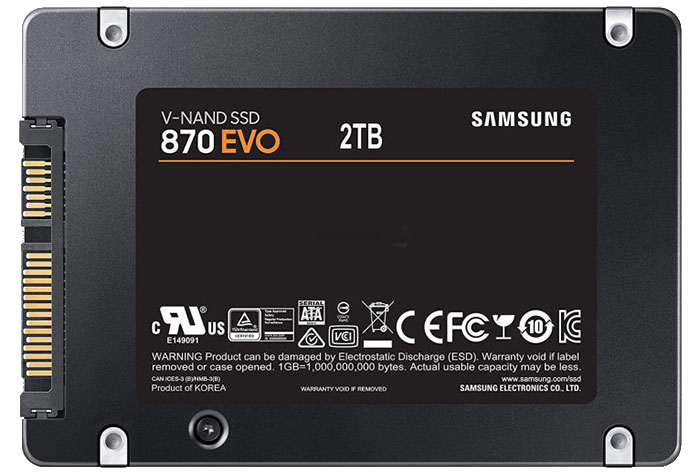 |
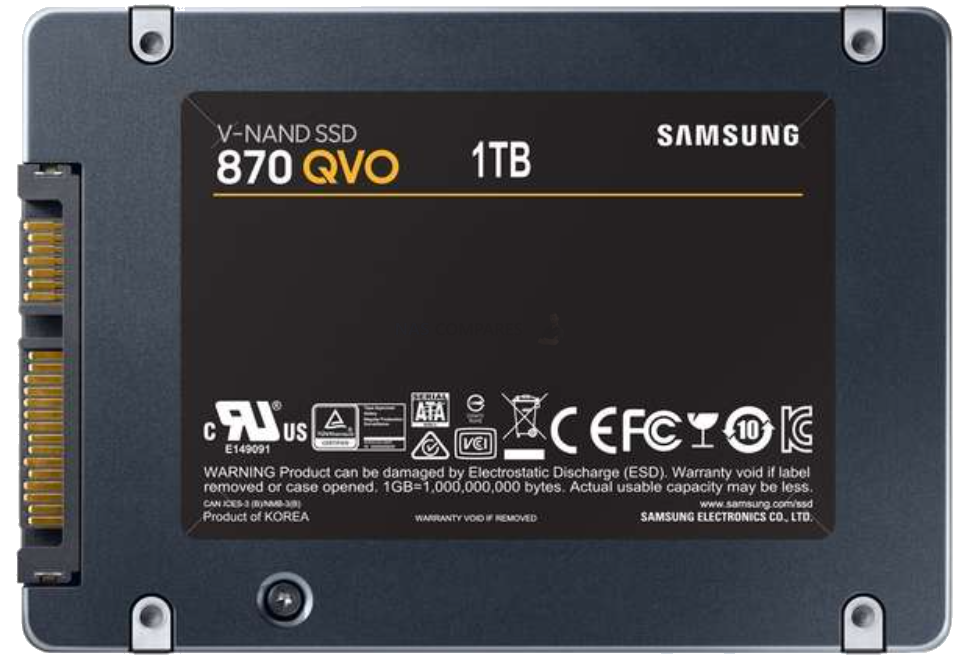 |
|
|
|
|
| Interface | SATA 6Gbps | SATA 6 Gbps |
| Form Factor | 2.5-inch | 2.5-inch |
| Storage Memory | Samsung V-NAND 3-bit MLC (TLC) | Samsung V-NAND 4-bit MLC (QLC) |
| Controller | Samsung Controller | Samsung MKX Controller |
| DRAM | 4GB LPDDR4 (4TB) 2GB LPDDR4 (2TB) 1GB LPDDR4 (1TB) 512MB LPDDR4 (250/500GB) |
8GB LPDDR4 (8TB) 4GB LPDDR4 (4TB) 2GB LPDDR4 (2TB) 1GB LPDDR4 (1TB) |
| Capacity | 4TB, 2TB, 1TB, 500GB, 250GB | 8TB, 4TB, 2TB, 1TB |
| Sequential Read/Write Speed | Up to 560/530 MB/s | Up to 560/530 MB/s |
| Random Read/Write Speed | Random Read 98K, Write 88K IOPS | Up to 98K/88K IOPS |
| Management Software | Samsung Magician | Samsung Magician |
| Total Bytes Written | 2,400TBW (4TB) 1,200TBW (2TB) 600TBW (1TB) 300TBW (500GB) 150TBW (250GB) |
2,880TB (8TB) 1,440TB (4TB) 720TB (2TB) 360TB (1TB) |
| Warranty | Five-year Limited Warranty | Three-year limited warranty |
The Samsung 970 EVO and 970 EVO Plus – All Round NVMe Greatness
And so we naturally now make the move from SATA to the hugely popular NVMe interface drives from Samsung. The benefits in performance that the PCIe based NVMe connected drives have brought to ALL areas of computer storage cannot be understated! Samsung currently has two main irons in the fire when it comes to NVMe storage and we will talk first about the more consumer-grade option, Samsung 970 EVO and EVO Plus. The Samsung 970 EVO Plus features the brand’s latest fifth-generation V-NAND technology offers performance 8x that of the drives mentioned so far, making it considerably more suitable at tackling demanding tasks, such as 4K content editing, 3D modelling and simulation as well as heavy gaming. The Samsung 970 Evo is also the SSD I would recommend for NAS caching use in Synology and QNAP Servers (which are all gradually featuring NVMe caching bays as standard) over any other Samsung SSD currently.
| Suitable For | Not Suitable For |
|
Modern PC Gaming NAS Caching HD/1080P Photo/Video Editing Post Production Flash Storage (May Require U.2 Adapters) |
4K/8K Editing RAID Storage PS5 Storage M.2 SATA environments (No point) |
As one might expect, the Samsung 970 EVO Plus achieves significant performance improvements (a reported 57% increase) and increased power efficiency over its predecessor, the 960 Pro (released at the end of 2018). The Samsung 970 EVO Plus SSD delivers sequential and largely sustained performance of up to 3,500MB/s Write and up to 3,300 MB/s, write, while random speeds come in at up to 620,000 Read IOPS and up to 560,000 Write IOPS.
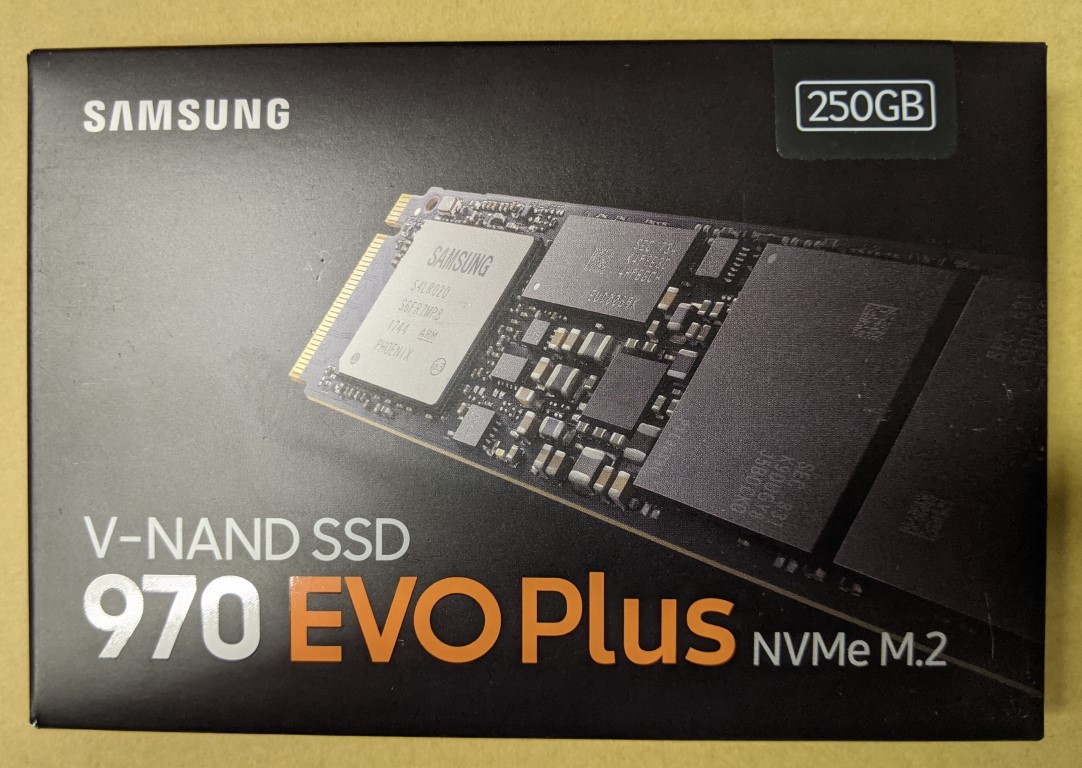
That said, it is imperative that users understand that you cannot take advantage of the performance benefits of the Samsung EVO and EVO Plus without a supported M.2 NVMe client (of at last PCIe Gen 3×4 architecture, as the 970 EVO Plus comes in a compact M.2 NVMe 1.3 form factor (though there are some PCIe Card-to-NVMe SSD port adapters on the market to work around this for Tower-PC users. Because this uses that popular TLC NAND and highly competent controller, the Samsung 970 EVO Plus also offers a five-year limited warranty or up to 1,200 terabytes written. Finally, in terms of capacity, the 970 EVO Plus arrives at 250GB, 500GB, 1TB and 2TB capacity modules, with a promised 4TB model arriving shortly as NAND improves – but don’t hold out for it.
Key Specifications
| Category | 970 EVO Plus | 970 EVO |
| Design |  |
 |
| Interface | PCIe Gen 3.0 x4, NVMe 1.3 | PCIe Gen 3.0 x4, NVMe 1.3 |
| Form Factor | M.2 (2280) | M.2 (2280) |
| Storage Memory | Samsung 9x-layer V-NAND 3-bit MLC | Samsung 64-layer V-NAND 3-bit MLC |
| Controller | Samsung Phoenix Controller | Samsung Phoenix Controller |
| DRAM | 2GB LPDDR4 DRAM (2TB) 1GB LPDDR4 DRAM (1TB) 512MB LPDDR4 DRAM (250 / 500GB) |
2GB LPDDR4 DRAM (2TB) 1GB LPDDR4 DRAM (1TB) 512MB LPDDR4 DRAM (250 / 500GB) |
| Capacity5 | 2TB, 1TB, 500GB, 250GB | 2TB, 1TB, 500GB, 250GB |
| Sequential Read / Write Speed | Up to 3,500 / 3,300 MB/s | Up to 3,500 / 2,500 MB/s |
| Random Read / Write Speed
(QD32) |
Up to 620,000 / 560,000 IOPS | Up to 500,000 / 480,000 IOPS |
| Management Software | Samsung Magician Software | Samsung Magician Software |
| Data Encryption | Class 0 (AES 256), TCG/Opal v2.0, MS eDrive (IEEE1667) | Class 0 (AES 256), TCG/Opal v2.0, MS eDrive (IEEE1667) |
| Total Bytes Written | 1,200TB (2TB) 600TB (1TB) 300TB (500GB) 150TB (250GB) |
1,200TB (2TB) 600TB (1TB) 300TB (500GB) 150TB (250GB) |
| Warranty | Five-year Limited Warranty | Five-year Limited Warranty |
The Samsung 980 Pro – Go Big or Go Home
Which leads us neatly too, arguably, the highest performing SSD that Samsung offer for consumer purchasing (at least of early 2021). In fact, they were practically the first brand to release a Prosumer/consumer targetted PCIe 4.0 NVMe solid-state drive, with the Samsung SSD 980 PRO. They were not technically the first (that would be Sabrent and/or Kingston) but Samsung was the first almost exclusively in-house brand to release a PCIe Gen 4 NVMe SSD – upgrading a whole bunch of things (from the Samsung controller and NAND layering, to NVMe revision and internal disk encryption) The new 980 PRO is designed for professionals and consumers who want cutting-edge performance in their high-end PCs, workstations and game consoles. Before going any further, you need to keep in mind that the true MVP here is the PCIe bandwidth available to the Samsung 980 Pro, with a potential 8,000MB/s bandwidth at PCIe 4×4, the controller on the 980 PRO is ideal for consumers and professionals who work with 4K and 8K contents, and play graphics-heavy games. All the key components, including the custom Elpis controller, V-NAND and DRAM, are completely designed in-house at Samsung to deliver a huge amount of potential from PCIe 4.0. So, this combination of high-grade components allows the Samsung 980 PRO to provide the sequential performance of up to 7,000MB/s Read and 5,000 MB/s write, as well as random read and write IOPs of upto 1,000K, making it up to two times faster than the Samsung 970 EVO Plus SSD and up to 12.7 times faster than Samsung 860 SSDs.
| Suitable For | Not Suitable For |
|
4K/8K Editing PS5 Storage (awaiting confirmation) 2020 Premium Motherboards Systems with PCIe Gen 4 slots and an M.2 adapter Card |
PCIe Gen 3 and Lower Systems (bottlenecked) XBOX Series X (Proprietary Storage) Most NAS Systems (PCIe Limit in 2020/2021) |
The Samsung 980 Pro is actually pretty impressive for more than just the usual speed and NAD endurance reasons, but also for innovations in heat management – a real killer for both endurance and performance long term. The 980 PRO comes with outstanding thermal control solutions for improved reliability. While most of today’s high-performance NVMe SSDs rely on external copper heatsinks to diffuse heat, Samsung’s 980 PRO employs a nickel coating on the controller as well as a heat spreader label on the backside of the SSD for efficient thermal management. These innovative heat-dissipating functions also allow the drive to maintain its compact and slim M.2 form factor. Samsung’s Dynamic Thermal Guard technology further ensures that the drive’s temperature stays at the optimal level, minimizing performance fluctuations over the long haul.
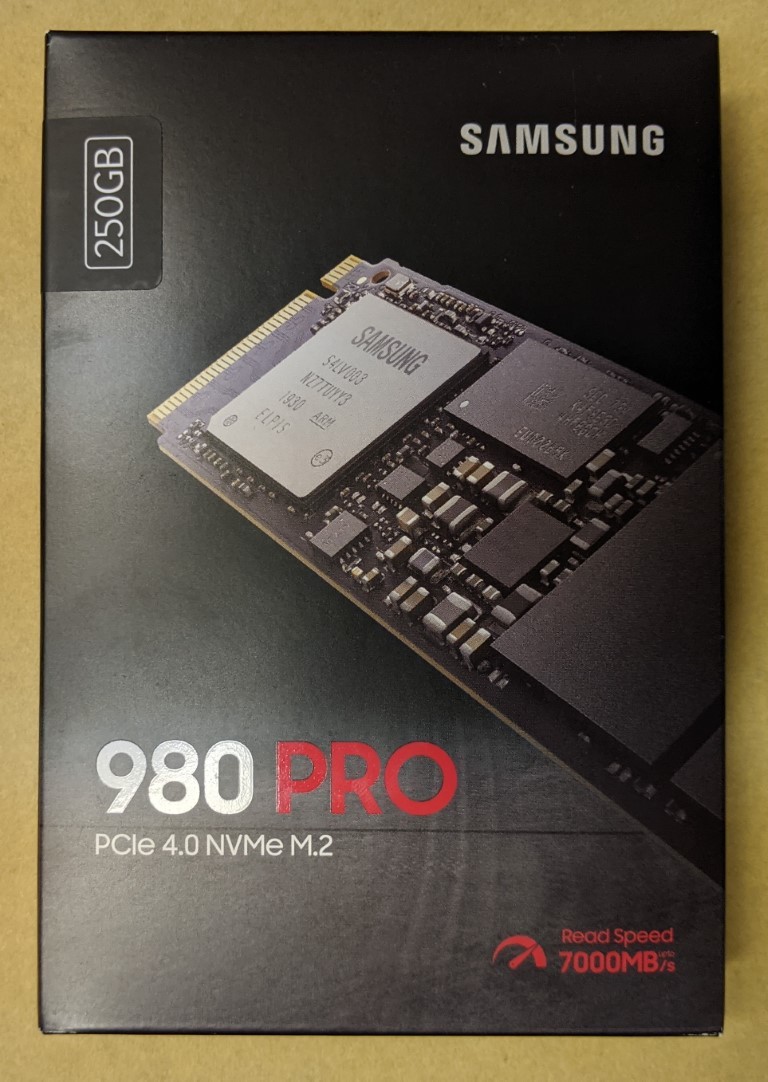
As good as all this sounds, it is still worth remembering that this series (at the time of writing) is in the early stages of its product life and currently only available in 250GB-2TB capacities. with only improvements in NAND management or adoption of longer 22110 NVMe m.2 modules allowing 4TB in future. Likewise, you are ONLY going to be able to harness that 7,000MB/s maximum performance if you install the Samsung 980 Pro in a system that features a PCIe Gen 4 x4 Architecture (NVMe 1.3 or 1.3c revision also), which is actually quite thin on the ground in 2020/2021. Most recent NVMe released hardware will feature NVMe PCIe Gen 3 x4, which will instantly bottleneck this 7000/5000MB/s SSD to 3500-4000MB/s (system depending). Otherwise, as PCIe 4 NVMe continue to arrive on the market (such as the Sabrent Rocket Plus, Kingston Ghost Tree, perhaps a Seagate Firecuda 530?) and client devices evolve, this is the kind of SSD that content creators and 4K/8K working professionals should be considering in the long term.
| Category | Samsung SSD 980 PRO |
| Design |  |
| Interface | PCIe 4.0 x4, NVMe 1.3c |
| Form Factor | M.2 (2280) |
| Storage Memory | Samsung 1xx-layer V-NAND 3-bit MLC |
| Controller | Samsung Elpis Controller |
| DRAM | 1GB LPDDR4 (1TB) 512MB LPDDR4 (500GB, 250GB) |
| Capacity4 | 1TB, 500GB, 250GB |
| Sequential Read/Write Speed | Up to 7,000 MB/s, Up to 5,000 MB/s |
| Random Read/Write Speed (QD32) |
Up to 1,000K IOPS, 1,000K IOPS |
| Management Software | Samsung Magician Software |
| Data Encryption | AES 256-bit Full Disk Encryption, TCG/Opal V2.0, Encrypted Drive (IEEE1667) |
| Total Bytes Written | 600TB (1TB)
300TB (500GB) 150TB (250GB) |
| Warranty | Five-year Limited Warranty |
The important thing to take away from this guide is that modern SSDs are built to last a considerable amount of time. While their life-cycle should be taken into account, it should by no means prevent you from buying faster and more efficient storage, just be sure to check the compatibility of your SSD and Client device in advance. So, there you have it. That is my guide to choosing the right Samsung SSD Right, the first time. If you found this guide helpful, that is great to hear! If you are still unsure what SSD you need, or need help choosing a compatible SSD drive, use our completely free and impartial advice section below. It’s manned by just me (with a little help from Eddie the Web Guy) and is not run with profit in mind – I can’t promise to reply fast, but I WILL reply!
Alternatively, you can use my buyer’s guides below (just click the right image) for Seagate SSDs and WD SSDs to buy in 2020/2021.
| Click Below for the Seagate SSD Buyers Guide | Click Below for the WD SSD Buyers Guide |
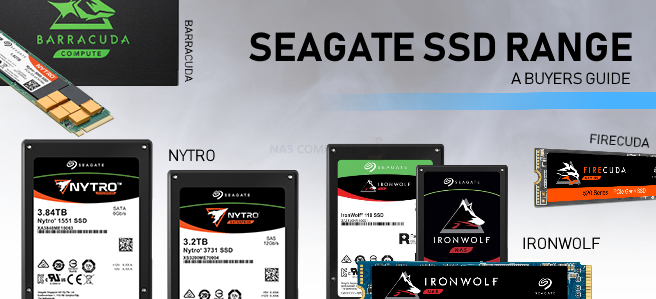 |
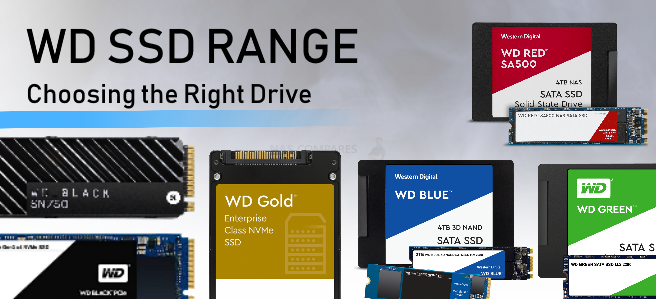 |
📧 SUBSCRIBE TO OUR NEWSLETTER 🔔
🔒 Join Inner Circle
Get an alert every time something gets added to this specific article!
This description contains links to Amazon. These links will take you to some of the products mentioned in today's content. As an Amazon Associate, I earn from qualifying purchases. Visit the NASCompares Deal Finder to find the best place to buy this device in your region, based on Service, Support and Reputation - Just Search for your NAS Drive in the Box Below
Need Advice on Data Storage from an Expert?
Finally, for free advice about your setup, just leave a message in the comments below here at NASCompares.com and we will get back to you. Need Help?
Where possible (and where appropriate) please provide as much information about your requirements, as then I can arrange the best answer and solution to your needs. Do not worry about your e-mail address being required, it will NOT be used in a mailing list and will NOT be used in any way other than to respond to your enquiry.
Need Help?
Where possible (and where appropriate) please provide as much information about your requirements, as then I can arrange the best answer and solution to your needs. Do not worry about your e-mail address being required, it will NOT be used in a mailing list and will NOT be used in any way other than to respond to your enquiry.

|
 |
A Buyer's Guide to Travel Routers - GET IT RIGHT, FIRST TIME
Jonsbo N6 DIY NAS Case Review
The Best Bits (and Worst Bits) of NAS of 2025!
Minisforum MS-02 Ultra Review
Minisforum N5 NAS, 6 Months Later - Better, Worse, the Same?
Beelink ME Pro NAS Revealed
Access content via Patreon or KO-FI





Discover more from NAS Compares
Subscribe to get the latest posts sent to your email.


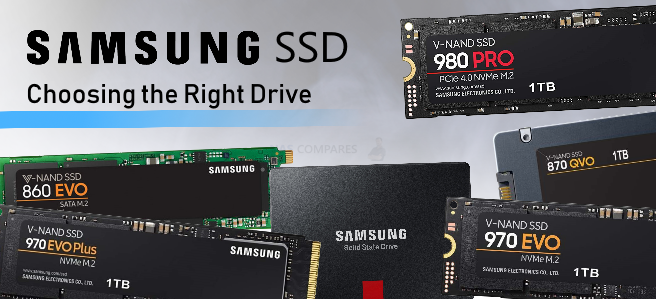





A really good & detailed video ????
REPLY ON YOUTUBE